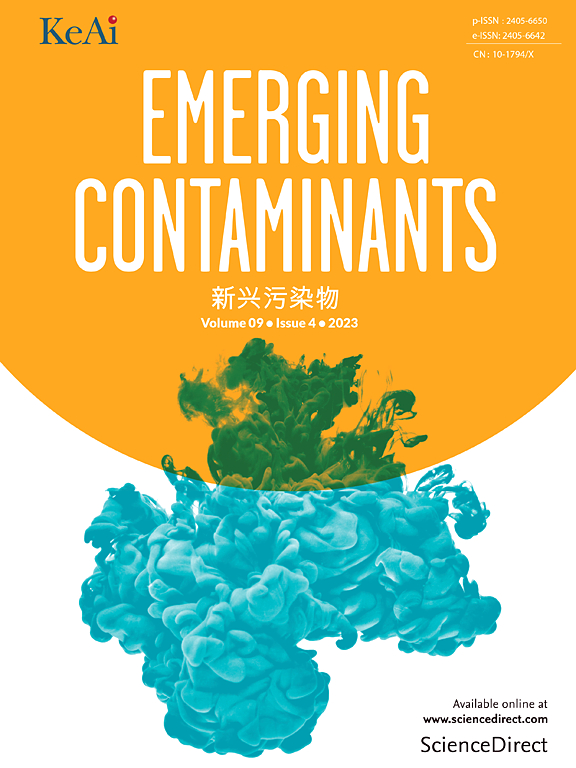Molecular response of Physarum melleum GZ381 to anatase TiO2 nanoparticles: Characteristic and application
IF 6.9
2区 环境科学与生态学
Q1 ENVIRONMENTAL SCIENCES
引用次数: 0
Abstract
Environmental pollution caused by nano titanium dioxide (nTiO2) has become an increasingly pressing issue. Investigating environmental organisms capable of tolerating nTiO2 stress, along with their molecular responses, can help us combat such pollution. In this study, we used multi-omics approaches, genetic manipulation, and physiological and biochemical methods to analyze the responses of Physarum melleum GZ381—which tolerates anatase-type nTiO2 (nTiO2-A) approximately 30 nm in size—and its responsive biomolecules. We observed that the primary molecular response characteristic of GZ381 was related to metabolism. Furthermore, we found that GZ381 utilizes circular RNA08121 in a competitive endogenous RNA network to regulate the transcriptional abundance of many metabolism-related genes, facilitating metabolic reprogramming and conferring obvious anti-nTiO2-A stress capabilities. Based on these findings, we designed mitigation schemes that markedly enhanced the tolerance of various non-tolerant cells to nTiO2-A of different sizes (approximately 30, 60, and 90 nm) under light and dark conditions. Overall, this study reports some important biomolecules that can enhance cellular nTiO2-A resistance and may be used to combat such pollution in the future, deepens the understanding of environmental organisms, especially those tolerant to nTiO2 stress, and provides new inspiration for combating such pollution challenges.
硬绒泡菌GZ381对锐钛矿型TiO2纳米颗粒的分子响应:特性及应用
纳米二氧化钛(nTiO2)引起的环境污染问题日益突出。研究能够耐受二氧化钛胁迫的环境生物,以及它们的分子反应,可以帮助我们对抗这种污染。在这项研究中,我们采用多组学方法、遗传操作和生理生化方法分析了melleum Physarum gz381 -耐受锐钛矿型nTiO2 (nTiO2- a)约30 nm的反应及其生物分子。我们观察到GZ381的主要分子响应特性与代谢有关。此外,我们发现GZ381在竞争性内源RNA网络中利用环状RNA08121调节许多代谢相关基因的转录丰度,促进代谢重编程,并赋予明显的抗ntio2 - a胁迫能力。基于这些发现,我们设计了缓解方案,在光照和黑暗条件下显著增强了各种非耐受性细胞对不同尺寸(约30、60和90 nm)的nTiO2-A的耐受性。总的来说,本研究报道了一些重要的生物分子,可以增强细胞对nTiO2- a的抗性,并可能在未来用于对抗这类污染,加深了对环境生物,特别是耐受nTiO2胁迫的生物的认识,为应对这类污染挑战提供了新的灵感。
本文章由计算机程序翻译,如有差异,请以英文原文为准。
求助全文
约1分钟内获得全文
求助全文
来源期刊

Emerging Contaminants
Medicine-Public Health, Environmental and Occupational Health
CiteScore
10.00
自引率
6.70%
发文量
35
审稿时长
44 days
期刊介绍:
Emerging Contaminants is an outlet for world-leading research addressing problems associated with environmental contamination caused by emerging contaminants and their solutions. Emerging contaminants are defined as chemicals that are not currently (or have been only recently) regulated and about which there exist concerns regarding their impact on human or ecological health. Examples of emerging contaminants include disinfection by-products, pharmaceutical and personal care products, persistent organic chemicals, and mercury etc. as well as their degradation products. We encourage papers addressing science that facilitates greater understanding of the nature, extent, and impacts of the presence of emerging contaminants in the environment; technology that exploits original principles to reduce and control their environmental presence; as well as the development, implementation and efficacy of national and international policies to protect human health and the environment from emerging contaminants.
 求助内容:
求助内容: 应助结果提醒方式:
应助结果提醒方式:


